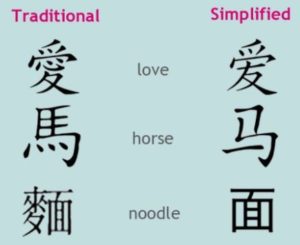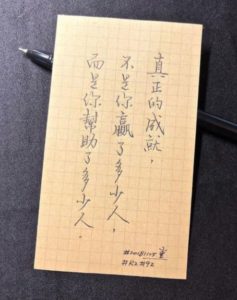
If you’re in Taiwan learning Chinese, you may be aware that the Chinese characters used in Taiwan (traditional) differ from those used in China (simplified). So which should you learn – simplified Chinese or traditional? Here are 6 reasons to choose traditional Chinese characters vs simplified.
1. You don’t have a choice
If you’re living in Taiwan, then you don’t really have a choice between learning traditional Chinese characters vs simplified. Traditional Chinese characters are what is used in Taiwan. There is no reason to learn simplified unless you plan to:
- Communicate with people from China
- Consume resources created in China or for Chinese users
If you don’t plan to do either of the above, then stick to traditional and move on to the next article.
2. Traditional Chinese characters are more meaningful
Many Chinese characters are pictorial representations of the meaning. For example the character 門 means “gate” or “door.” You can imagine the old saloon style swinging doors that kind of look like 門. The simplified version is reduced to 门 which while it can still visually be thought of as a door, has less meaning than the original.
Some characters are created as combinations of other characters. For example if you combine 木 (wood) with 日 (sun), you get the character 東 (East). You can think of viewing the sun rising through the woods to come up with the character for East. However the simplified character for East is 东 which loses the individual breakdown we see in the traditional version.
There are lots of other examples where the simplified version of a character removes elements that would help you understand the original meaning of the character. The character 愛 (love) includes the element 心 (heart) but is simplified to 爱 without the heart.
Learning traditional characters preserves the history and meaning of characters, much of which has been removed in their simplified versions.
3. Traditional characters are easier to learn
The irony of course is that traditional characters were simplified to make them easier to learn. The idea was that by reducing the number of strokes required, it would make the characters easier to learn. The side effect of this simplification process though is that the process of removing strokes removed many of the meaningful elements from characters.
Take the character 關 for example. It means “to close”. If you remember that 門 above means door, it’s not much of a stretch to view 關 as a locked (closed) version of 門.
Now compare this to the simplified versions of 门 (door) and 关 (close) which have no relation to each other and are just arbitrary replacements chosen for 門 and 關 respectively.
4. People rarely write anymore
The case for simplifying traditional characters made sense during the age when much information and correspondence was physically written down. A few seconds shaved here and there from not having to write as many strokes could add up to significant time saved over an extended period of time.
In the digital age we live in these days though, it’s rare for most of us to do much handwriting in any language. You may have to fill out a form once in a while, which involves writing your name and perhaps your street address at most. The time saved from writing fewer strokes is pretty insignificant.
5. A natural simplification process already exists

If you’ve watched locals writing in Chinese, you’ll notice a lot of written characters look very different from their original forms. In the same way most people writing in English use a cursive format to combine strokes and improve their writing speed, the same thing happens in written Chinese.
So while it may take you several seconds to write out complicated traditional characters in their original form, native writers will be able to write them out much faster by combining strokes.
6. Traditional characters are just as fast to type out
As was touched upon above, most of our communication today tends to be digital. You are much more likely to use Chinese in an email or in a text message than having to write it out by hand. When it comes to typing, all the benefits to simplification disappear. You can type just as fast in traditional as you would in simplified. And in the odd case that you need to type in simplified, it’s as simple as changing the language character set on your keyboard and continuing on.
Have you started learning characters? What are your thoughts on learning traditional Chinese characters vs simplified? Let us know in the comments below.